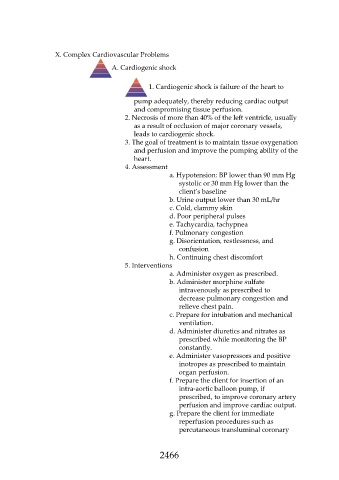Page 2466 - Saunders Comprehensive Review For NCLEX-RN
P. 2466
X. Complex Cardiovascular Problems
A. Cardiogenic shock
1. Cardiogenic shock is failure of the heart to
pump adequately, thereby reducing cardiac output
and compromising tissue perfusion.
2. Necrosis of more than 40% of the left ventricle, usually
as a result of occlusion of major coronary vessels,
leads to cardiogenic shock.
3. The goal of treatment is to maintain tissue oxygenation
and perfusion and improve the pumping ability of the
heart.
4. Assessment
a. Hypotension: BP lower than 90 mm Hg
systolic or 30 mm Hg lower than the
client’s baseline
b. Urine output lower than 30 mL/hr
c. Cold, clammy skin
d. Poor peripheral pulses
e. Tachycardia, tachypnea
f. Pulmonary congestion
g. Disorientation, restlessness, and
confusion
h. Continuing chest discomfort
5. Interventions
a. Administer oxygen as prescribed.
b. Administer morphine sulfate
intravenously as prescribed to
decrease pulmonary congestion and
relieve chest pain.
c. Prepare for intubation and mechanical
ventilation.
d. Administer diuretics and nitrates as
prescribed while monitoring the BP
constantly.
e. Administer vasopressors and positive
inotropes as prescribed to maintain
organ perfusion.
f. Prepare the client for insertion of an
intra-aortic balloon pump, if
prescribed, to improve coronary artery
perfusion and improve cardiac output.
g. Prepare the client for immediate
reperfusion procedures such as
percutaneous transluminal coronary
2466

